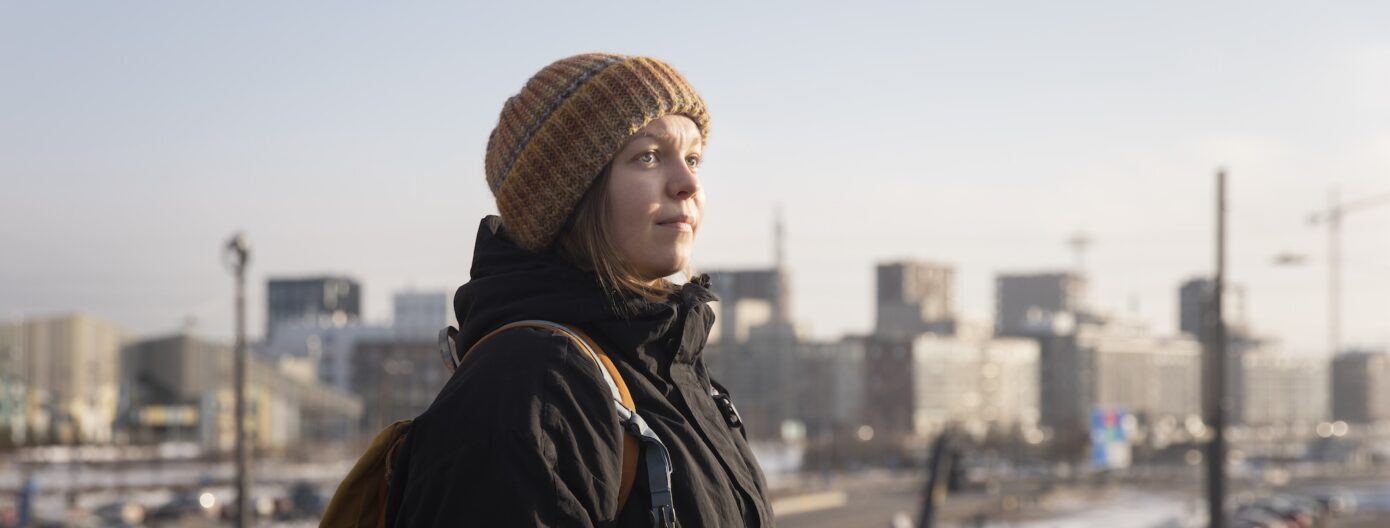Grassroots utopias of human-centered and sustainable cities are slowly but steadily becoming a reality. Urban researcher Linda Karjalainen focuses on making these visions visible and bringing researchers and citizens together to realize them.
It is said that change happens in cities. They pave the way for sustainable development and a green transition. Linda Karjalainen wants to understand what genuinely occurs within these urban settings: how people come together and act to make their environment socially and ecologically sustainable.
Working as a postdoctoral researcher at the Finnish Environment Institute (SYKE) and Aalto University, Karjalainen received a grant from the Nessling Foundation in November 2023 for a two-year research project. She examines citizens’ ways of using and shaping the urban environment and how these practices could be mainstreamed with the help of research knowledge.
“My research focuses on what citizens are already doing that makes urban spaces more accessible, enjoyable, and functional for those living there,” Karjalainen says. As a part of the project, she will create an accessible material bank for interested parties to keep up with what’s happening in their city.
Her research aligns with current grassroots movements: for example, citizens are advocating for a DIY skatepark in Suvilahti, and Helsinki’s first pedestrian association was recently established. “Everyone’s Helsinki”, a community built around inclusive urban planning, recently launched its activities to develop a fairer city.
“When enough people share the same idea at the same time, something significant is happening.”

Research supports citizens’ advocacy
Karjalainen’s research project will commence in December 2024 and consists of two main phases: group interviews with urban actors and co-development workshops with researchers. These will be conducted in collaboration with Femma Planning, an agency that specializes in participatory urban planning.
Based on citizens’ insights gathered in the workshops, researchers will develop ways to make research knowledge more accessible for city dwellers. Whether it will be a platform, a series of discussions, or something else entirely, is unsure yet: the final result will take its form based on the workshops.
“Research is often done with policy recommendations in mind. The priority seems to be figuring out ways to apply research findings to decision-making. However, what often gets left out is how citizens access this information,” Karjalainen notes.
According to her, citizens, whether individuals or groups, often advocate for the same things as research: for a more equitable and diverse urban space. A stronger bridge between laypeople and academia could help citizens influence their environment by participating in the ongoing conversation.
“Citizens could benefit from scientific arguments and analyses: familiarity with terminology helps in advocacy,” Karjalainen says. Urban planning and policy process researchers truly understand the language spoken in decision-making.
Interest sparked by urban environments
While Karjalainen works at Aalto University’s Department of Mechanical Engineering, her education and passion lie in social scientific environmental studies. Early in her studies, she became interested in urban research and eventually gravitated toward transportation research. Social aspects of transportation led her to her dissertation, which she completed in 2022. These themes also appear in the research funded by the Nessling Foundation.
Karjalainen is familiar enough with her subject matter to not view it through rose-tinted glasses. She launches into a succinct “mini-rant” about the unsustainability of transportation planning – “Up to 70% of urban space is allocated to motorists, who make up only about 40% of all city dwellers, and of this 40%, well over half are men” – and considers what else could be done in cities with the space freed from cars.

However, she wants to approach this frustration with urban planning from a perspective of change. For example, mainstream media perpetuates a narrative suggesting that the only way to revitalize declining city centers is to increase traffic. This argument has been around for years, despite being repeatedly debunked by research. According to Karjalainen, this says something.
“For example, the media’s way of reporting stems from the dominant position of car use, which has prevailed for decades. Some may find it difficult to let go of these views.”
Interest in citizens, not governance
In 2015, students at a primary school in Käpylä wanted to paint flowers and butterflies on the walls of a nearby underpass. The dreary concrete tunnel seemed intimidating to many, so colorful pictures would make it easier to pass through – and make the built environment more appealing. The bureaucratic process of permit application took four years. By the time the permit was finally granted, the original painters had already moved on to secondary school.
“I think about this case often. Come on. People must have agency in their environment,” Karjalainen says.
Because of cases like the underpass, she doesn’t intend to examine political decision-making regarding urban space or the current system at all in her research.
“If you want to achieve systemic change, power relations must also change. In this project, I want the freedom to explore alternatives to current power structures.”
Instead, Karjalainen focuses solely on narratives created and lived by citizens. These could be considered utopias, but many urban dwellers already live sustainable urban lives that remain overshadowed by the mainstream.
“By showcasing everything happening in Helsinki, for example, I can bring hope to the discussion on urban planning. The entire research setup is inspiring to me: it empowers both citizens and researchers to understand that their work matters.”
Pictures: Miikka Pirinen


